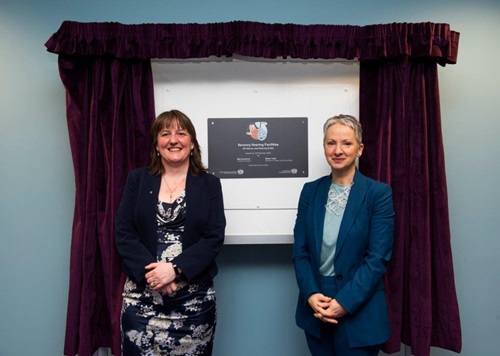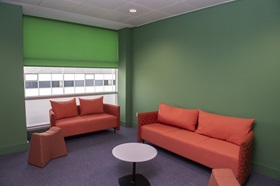
New hearing facilities for the additional support needs jurisdiction within the Health and Education Chamber of the First-tier Tribunal for Scotland in Glasgow were formally opened yesterday (25/02/2020) by Mrs May Dunsmuir, (right) Chamber President of the Health and Education Chamber and the Minister for Children and Young People, Maree Todd (left).
The new sensory hearing suites were designed after listening to children’s own views about how they could participate and be heard when it comes to decisions being made about their rights and educational needs.
Mrs May Dunsmuir had observed that in nearly three decades of work in child law and child welfare there was one glaring consistency – when a hearing of any nature takes place, the number of adults in the room swamps the child and their voice is invariably lost.
“Given this opportunity to help design new facilities I wanted to make sure we gave children every opportunity to take part and be heard. I began with these questions: Do children want to come to hearings? If not, how we can improve their participation in the process? If yes, how can we improve their participation in the process? This was about overcoming barriers.”
Her research involved speaking with children and young people across Scotland with a range of additional support needs, including children who are care experienced.
“What they clearly stated to me was they wanted to be able to come to hearings where decisions would be made about them.
“The hearing environment was crucial to their participation. They identified the need for a round table in the hearing room as this would be the right shape to help them feel equal and more involved. One child said it should be like King Arthur’s round table where all knights are equal. Seats at the table are all the same height and there is a separate break out area, where they can rest but still be present. Others asked for support to be there – the support that they would need; one child with a physical disability asked if there could be drinking straws. Sometimes removing barriers is as simple as providing a drinking straw.”
 Those voices were reflected in the final design, influencing the furnishings, fabrics, colours and flexible environments available in the sensory suites. Beyond the design and the new suites is the commitment to continuing to engage with children, identifying their needs before they attend hearings and making sure arrangements are tailored to their needs.
Those voices were reflected in the final design, influencing the furnishings, fabrics, colours and flexible environments available in the sensory suites. Beyond the design and the new suites is the commitment to continuing to engage with children, identifying their needs before they attend hearings and making sure arrangements are tailored to their needs.
Minister for Children and Young People Maree Todd said: “In Scotland we want our children and young people to grow up loved, safe and respected to realise their full potential.
“I am delighted that the new sensory hearing facilities have been developed with the child’s voice at the centre, enabling those with additional support needs to fully participate in the hearings process.”
At the age of 15, Kerrie McLeod volunteered as a young chamber consultant for the Health and Education Chamber. She helped test the needs to learn website and the images that were developed as part of this facility’s design.
Speaking at the opening yesterday she said: “At 15 it is common to think that your opinion doesn’t matter. Being asked for my view on the layout, images and colour scheme for the needs to learn website, which was something that at the time felt so small, made me feel that my opinion not only mattered but was valued. It is so nice to see the outcome of this work featuring in the hearings suite to help children and young people who will attend this hearing facility.
“This experience helped me to be accepted to University and I have this experience to thank for my confidence and ability to voice my opinion and involve myself in matters important to not only myself but others.” Kerrie is now 18.
The sensory hearing suite forms part of the Scottish Courts and Tribunals Service Evidence and Hearings Suite. The facility is also used by courts to allow children’s evidence to be pre-recorded or for children to give evidence remotely, away from a court room setting. Because of the personal and sensitive nature of their evidence and participation, we don’t publish the Glasgow address.
Notes
Description of the sensory hearing rooms facilities.
- An area with a round table and equal height chairs which look the same, where the tribunal members, parties and their representatives, the child and the witness(es) sit when giving their evidence.
- An area with two sofas, where the child, the tribunal members and any other appropriate persons can sit, if the child prefers to give their views or evidence from a sofa.
- A break-out area, with a screen, beanbag and small fridge, where the child can take a break from the hearing, whilst still remaining in the room, with access to fresh water.
- A sensory wall, which can be personalised with an image or colour of the child’s choice.
- In addition to these features of the hearing room, the following were developed:
- A separate sensory room for the child to rest or de-stress during proceedings.
- A 1-2-1 room where the child can give their views or evidence to one questioner, who is familiar to the child That person has an agreed list of questions. During this experience, the questioner and tribunal judge have a live hearing link. Tribunal members and parties can see and hear the child and questioner. The child is aware that others are observing but does not see or hear them. The 1-2-1 room is softy furnished with two armchairs.
Legislation and young people
Children and young people are always the subject of additional support needs tribunals, but may also be parties. The tribunal decides references from parents and young people in relation to decisions of education authorities regarding the provision of educational support, under the Education (Additional Support for Learning) (Scotland) Act 2004.
Since January 2018, children aged between 12 and 15 years who have capacity to make a reference and where their wellbeing will not be adversely affected by doing so, have been able to make two types of reference: one in relation to the statutory education plan in Scotland (the co-ordinated support plan), the other against the education authority’s assessment of their capacity or wellbeing. The jurisdiction also decides claims from parents, children and young people against responsible bodies regarding disability discrimination in school education, under the Equality Act 2010.’